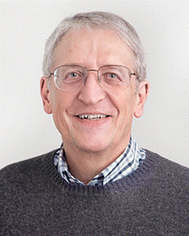Editor’s Choice: “Organic Electronics: What a Journey!”
Jean-Luc
Brédas
Department of Chemistry and Biochemistry, The University of Arizona Tucson, Arizona 85721-0041, USA
 Jean-Luc Brédas | Professor Jean-Luc Brédas received his BSc (1976) degree and PhD (1979) from the University of Namur, Belgium. In 1988, he was appointed as a professor at the University of Mons, Belgium, where he established the Laboratory for Chemistry of Novel Materials. While keeping an “Extraordinary Professorship” appointment in Mons, he joined the University of Arizona in 1999. In 2003, he moved to the Georgia Institute of Technology where he became a Regents’ Professor of chemistry and biochemistry and held the Vasser-Woolley and Georgia Research Alliance Chair in Molecular Design. Between 2014 and 2016, he joined King Abdullah University of Science and Technology (KAUST) as a distinguished professor and served as Director of the KAUST Solar & Photovoltaics Engineering Research Center. He returned to Georgia Tech in 2017 before moving back to the University of Arizona in 2020 where he is currently Regents Professor in the Department of Chemistry and Biochemistry. Brédas is an elected Member of the International Academy of Quantum Molecular Science, the Royal Academy of Belgium, and the European Academy of Sciences. Recent honors include the 2013 American Physical Society David Adler Lectureship Award in the Field of Materials Physics, the 2016 American Chemical Society Award in the Chemistry of Materials, the 2019 Alexander von Humboldt Research Award, the 2020 Materials Research Society Materials Theory Award, and a 2021 Centenary Prize from the Royal Society of Chemistry. He is an Honorary Professor of the Institute of Chemistry of the Chinese Academy of Sciences and holds an Adjunct Professorship at the Georgia Institute of Technology. His Focus article “Mind the Gap” (https://pubs.rsc.org/en/content/articlelanding/2014/mh/c3mh00098b) was the first article that appeared in the very first issue of Materials Horizons. |
This year marks the fiftieth anniversary of a key milestone in the field of organic electronics, i.e., the first reports of metallic-like conductivity in the purely organic material tetrathiafulvene-tetracyanoquinodimethane (TTF-TCNQ), independently by the group of Dwaine Cowan at Johns Hopkins University1 and the groups of Alan Heeger and Tony Garito at the University of Pennsylvania.2 Soon thereafter came the report of high electrical conductivity upon doping (i.e., oxidation or reduction) of the organic polymer trans-polyacetylene, by Alan Heeger, Hideki Shirakawa, Alan McDiarmid, and their co-workers.3 This latter work offered the promise of combining in a single material, the electrical properties of metals with the flexibility of polymers, and led to the 2000 Nobel Prize in Chemistry.
These discoveries arguably mark the beginning of the field of organic electronics. While early on, much of the emphasis was placed on developing highly electrically conducting systems, by the late 1980’s much work had been performed to start exploiting the semiconducting properties of pristine π-conjugated organic materials, with initial impact in organic light-emitting diodes (OLEDs), organic solar cells, and thin-film transistors.
Since then, what a journey for organic electronics, so to celebrate the 50th anniversary of TTF-TCNQ, we are offering this Editor’s Choice collection, which gathers some of the recent, highly cited primary research articles published in Materials Horizons around the theme of organic electronics. The collection is meant to highlight the remarkable diversity and broad impact that organic electronics research now represents.
More specifically, the articles in the collection address:
• a range of sophisticated characterization techniques to better assess the electronic and structural properties via, for instance, optically detected magnetic resonance (https://doi.org/10.1039/D1MH00999K), monitoring of trap dynamics (https://doi.org/10.1039/D0MH00706D), in situ terahertz spectroscopy (https://doi.org/10.1039/D1MH01343B), probing static vs. dynamic disorder (https://doi.org/10.1039/D0MH00385A) and excited-state vibrational couplings (https://doi.org/10.1039/D2MH00829G), IR spectroscopy depth profiling (https://doi.org/10.1039/D0MH02047H), or solid-state NMR spectroscopy (https://doi.org/10.1039/D1MH01574E);
• the issue of free-charge yield (https://doi.org/10.1039/D1MH01331A);
• the factors that impact doping efficiency (https://doi.org/10.1039/D1MH01019K, https://doi.org/10.1039/D1MH01357B);
• understanding organic crystalline growth (https://doi.org/10.1039/D2MH00854H) and improving green-solvent processing (https://doi.org/10.1039/D0MH00785D);
• engineering the band structure of 2D covalent organic frameworks to generate topological features in purely organic systems (https://doi.org/10.1039/D1MH00935D);
• the development of interfaces for better carrier injection (https://doi.org/10.1039/D1MH00859E, https://doi.org/10.1039/D1MH01845K) and of hybrid organic–inorganic 2D perovskites (https://doi.org/10.1039/D0MH01904F, https://doi.org/10.1039/C9MH01917K);
• the potential impact of chiral structures (https://doi.org/10.1039/D1MH01119G, https://doi.org/10.1039/D2MH00698G); and;
• a range of applications, from thermoelectric generators (https://doi.org/10.1039/D0MH01679A) to IR or visible photodetectors (https://doi.org/10.1039/D2MH00479H, https://doi.org/10.1039/D1MH00776A), nonlinear optics (https://doi.org/10.1039/D1MH01206A), memories (https://doi.org/10.1039/D0MH00203H), energy storage (https://doi.org/10.1039/D2MH00912) and biological applications in terms of monitoring lipid bilayers (https://doi.org/10.1039/D0MH00548G) or generating neural networks (https://doi.org/10.1039/D3MH00775H, https://doi.org/10.1039/D3MH00858D).
We hope our readers will enjoy this collection as much as we do!
References
- J. Ferraris, D. O. Cowan, V. Walatka and J. H. Perlstein, Electron Transfer in a New Highly Conducting Donor–Acceptor Complex, J. Am. Chem. Soc., 1973, 95(3), 948–949 CrossRef CAS.
- L. B. Coleman, M. J. Cohen, D. J. Sandman, F. G. Yamagishi, A. F. Garito and A. J. Heeger, Superconducting Fluctuations and the Peierls Instability in an Organic Solid, Solid State Commun., 1973, 12(11), 1125–1132 CrossRef CAS.
- H. Shirakawa, E. J. Louis, A. G. MacDiarmid, C. K. Chiang and A. J. Heeger, Synthesis of Electrically Conducting Organic Polymers: Halogen Derivatives of Polyacetylene, (CH)x, J. Chem. Soc., Chem. Commun., 1977, 578–580 RSC.
| This journal is © The Royal Society of Chemistry 2023 |
